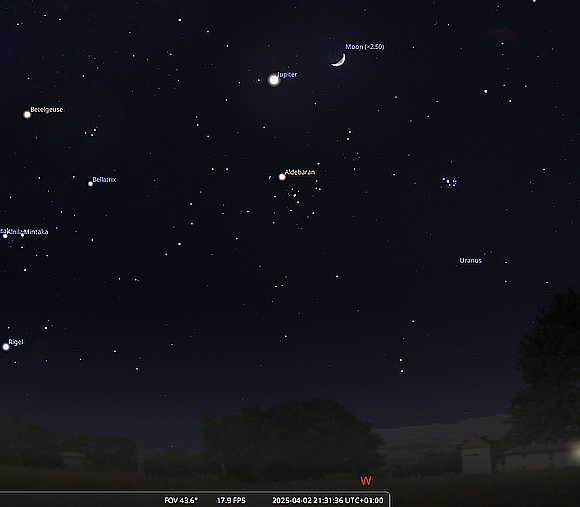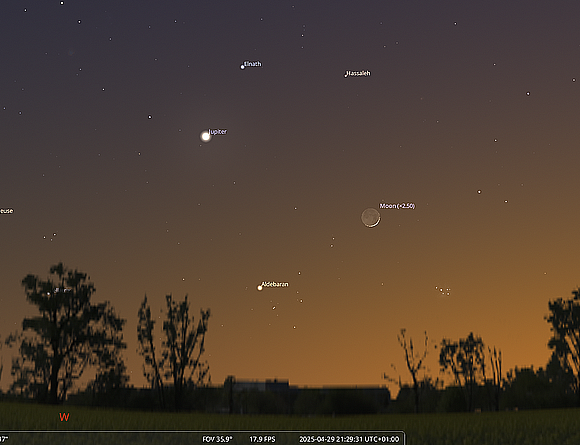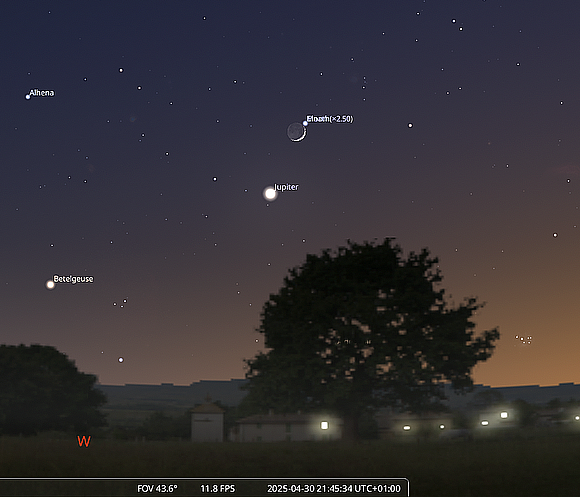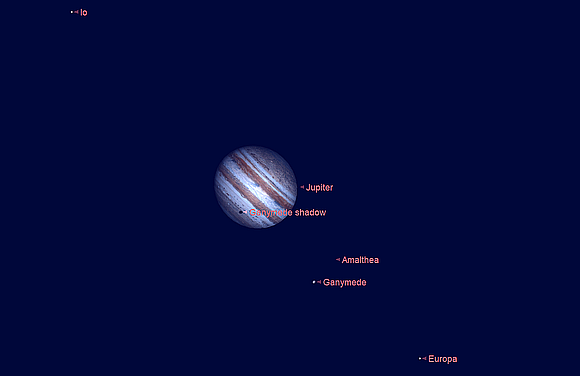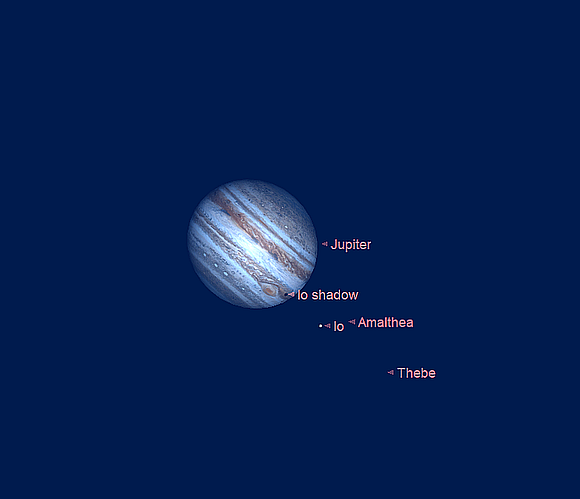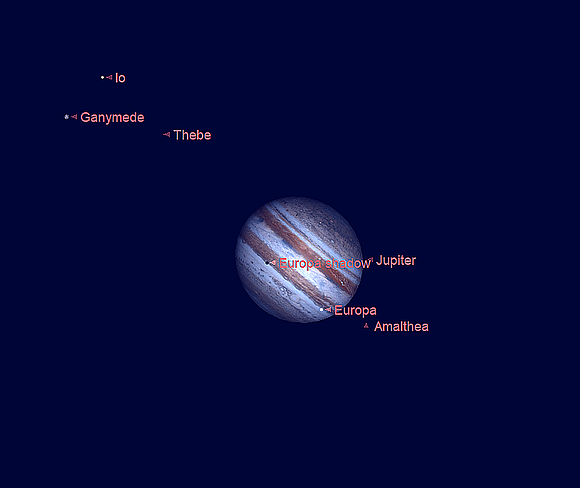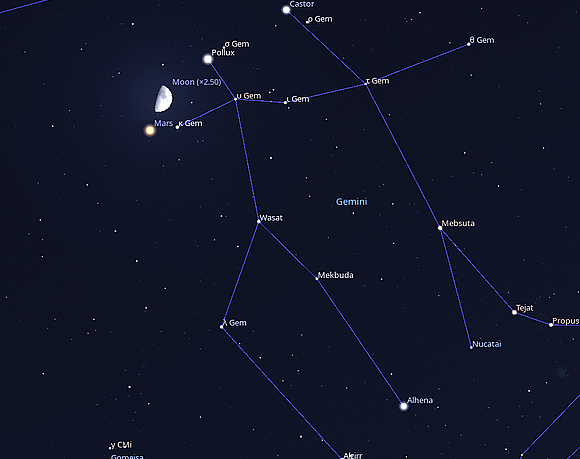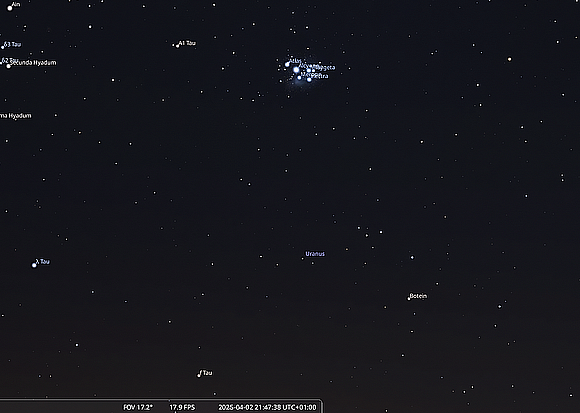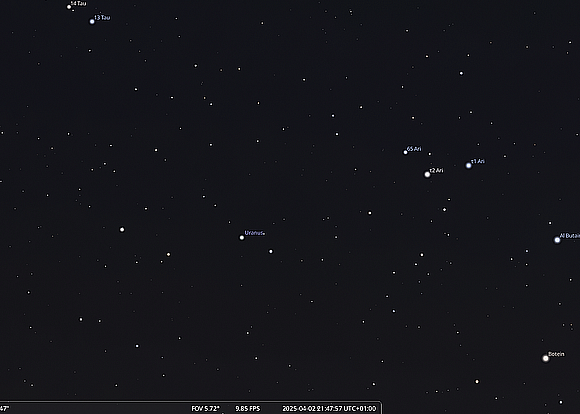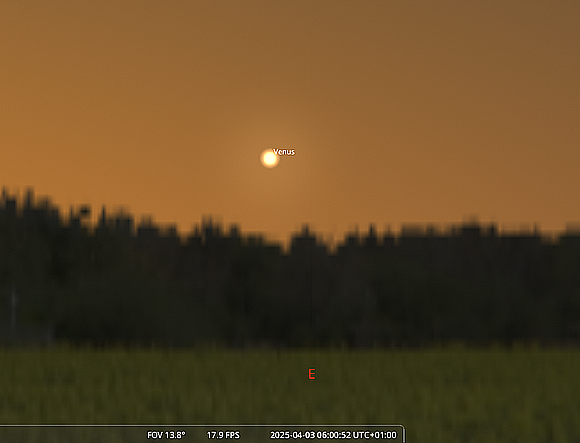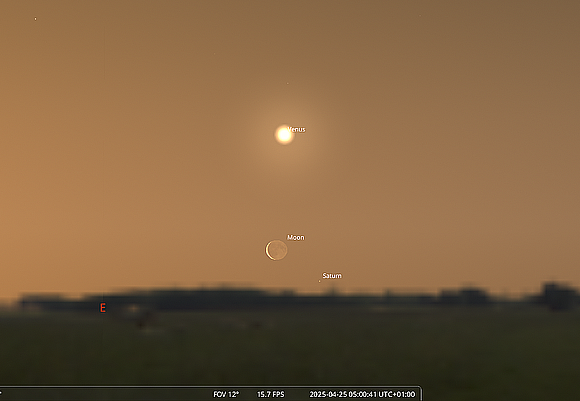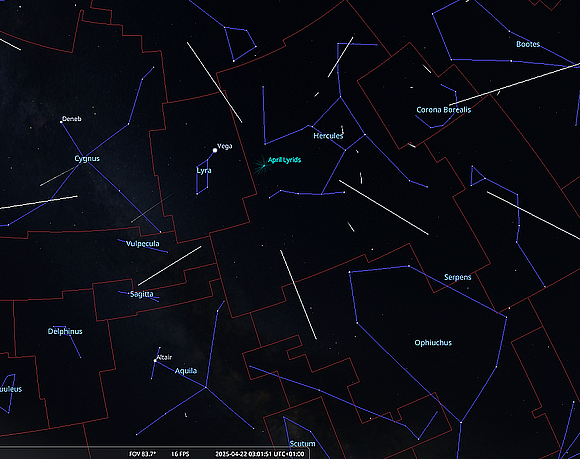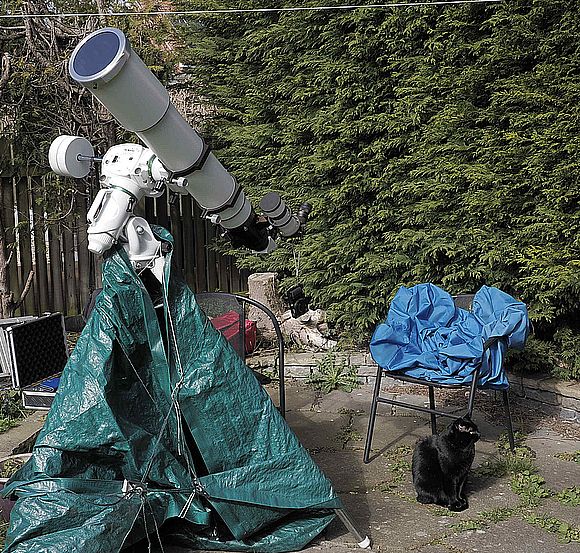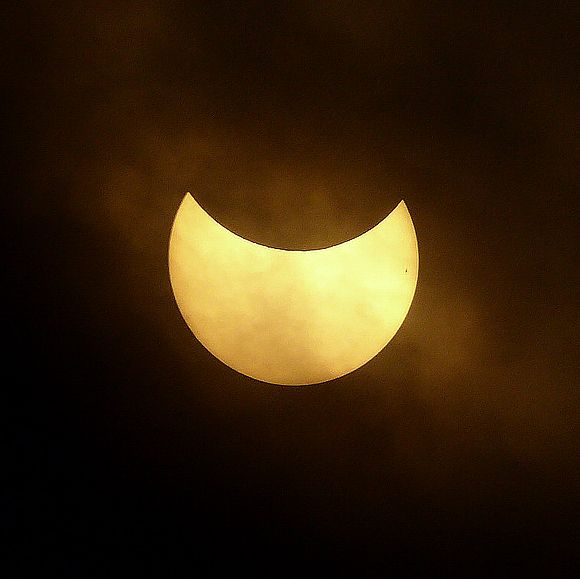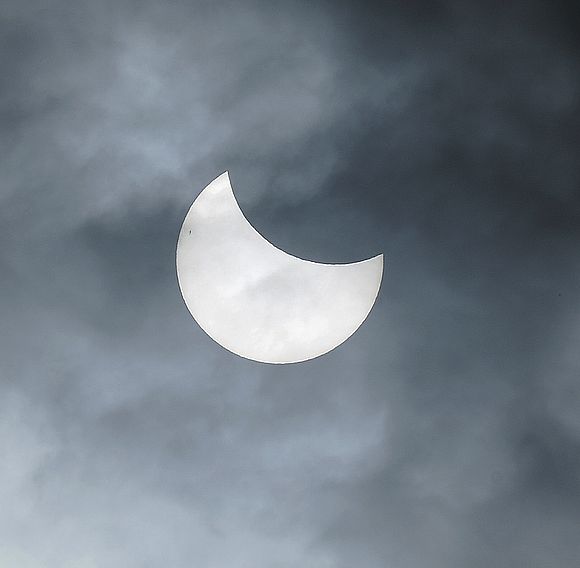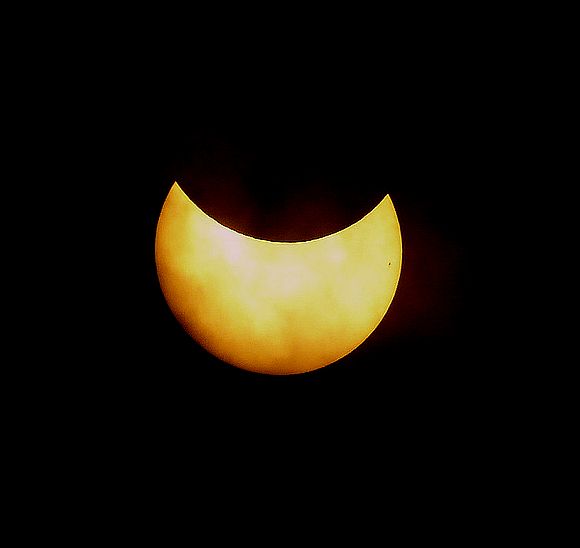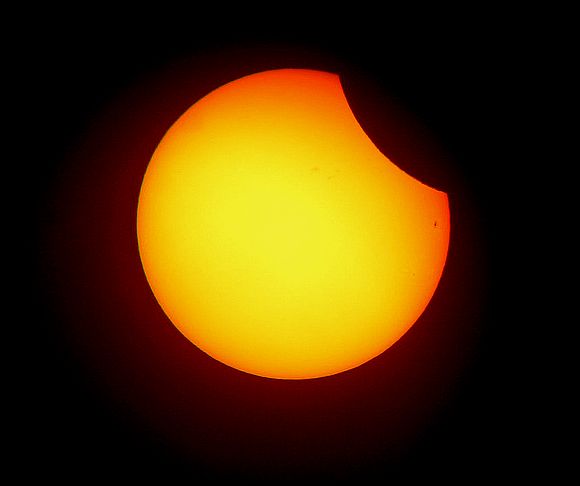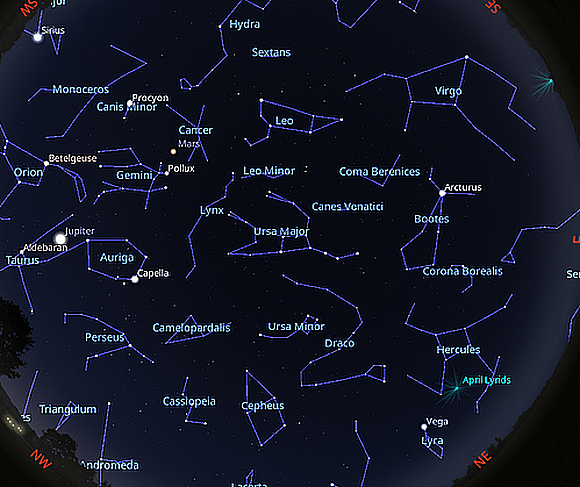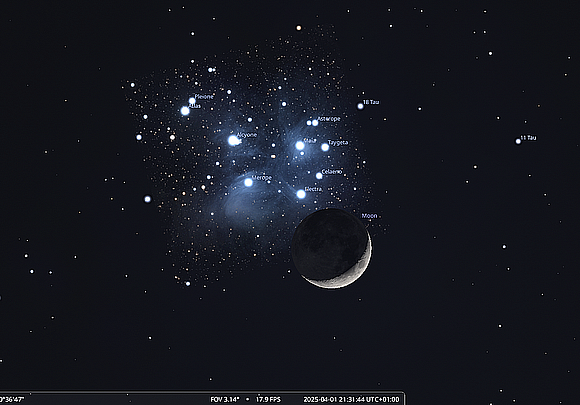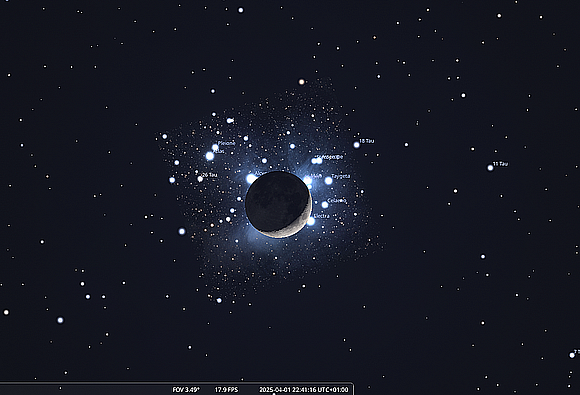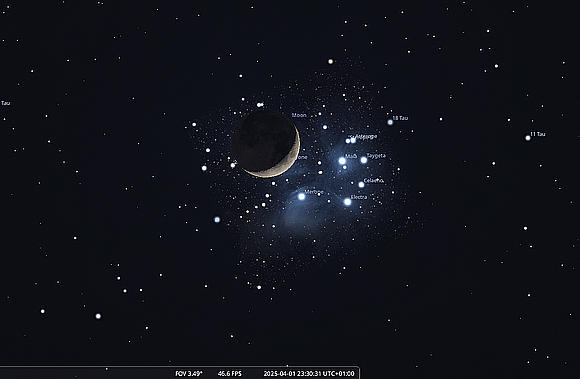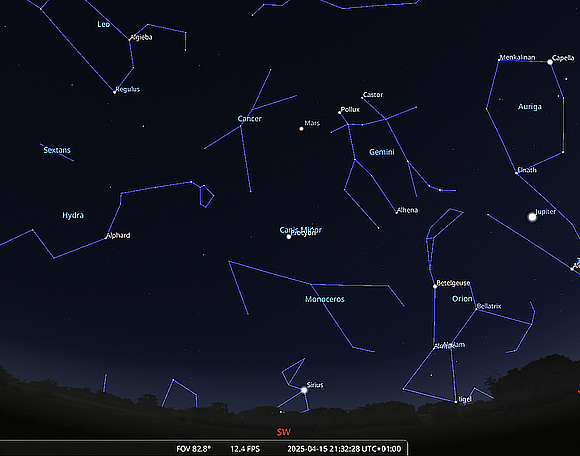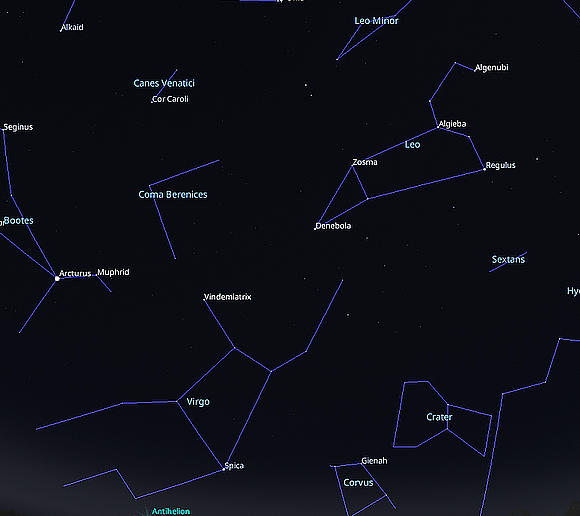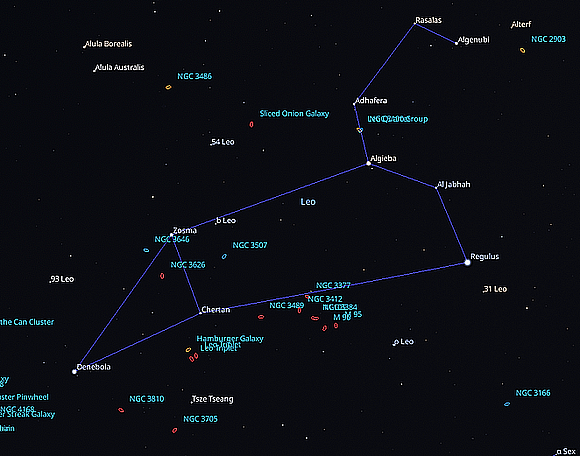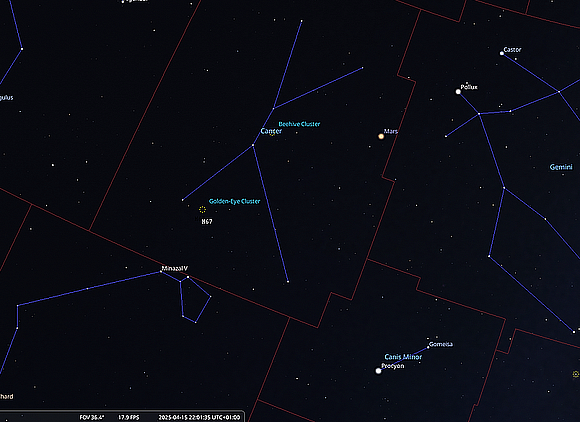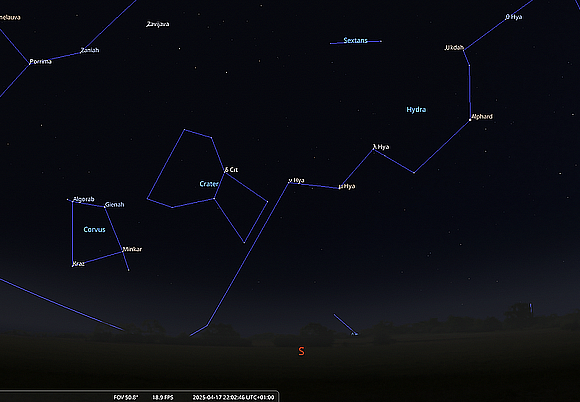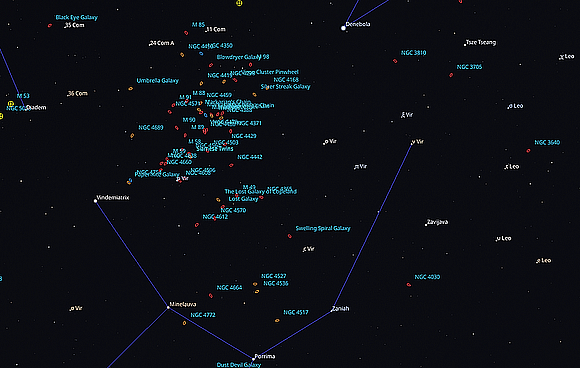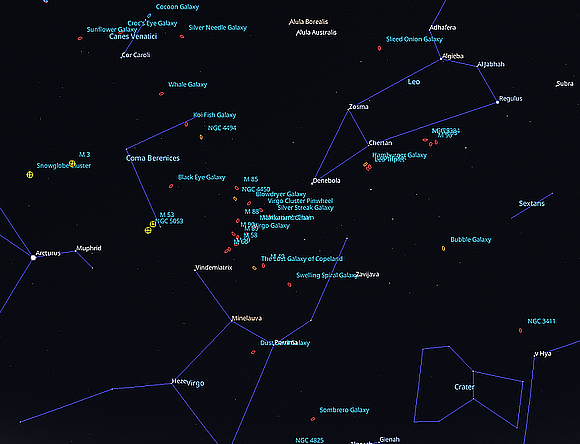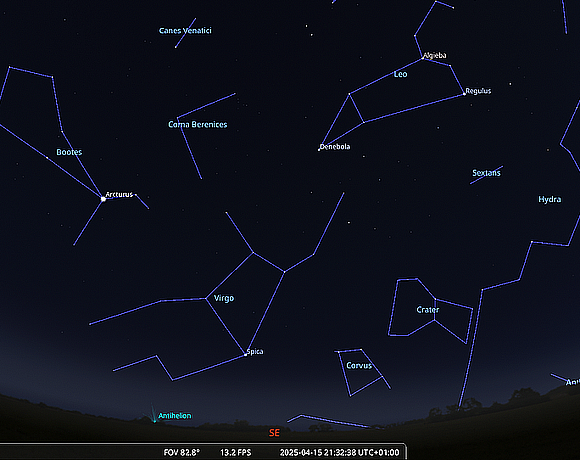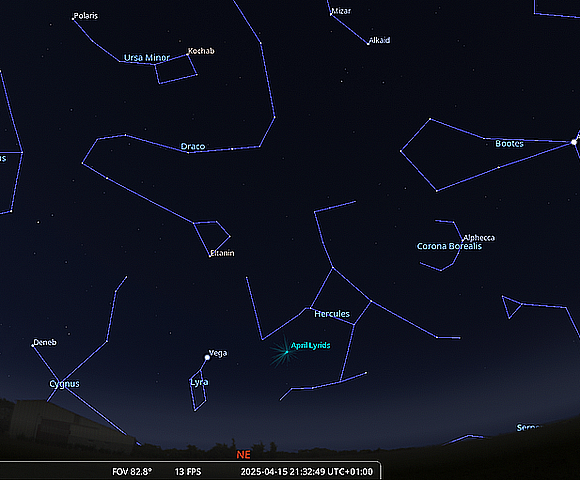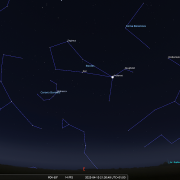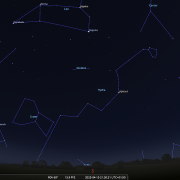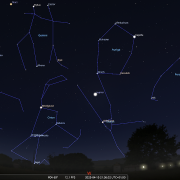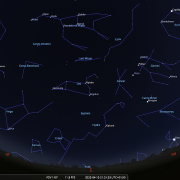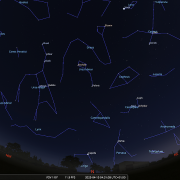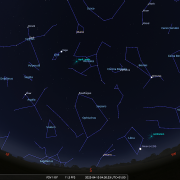In this month's Sky Notes:
Planetary Skylights: A Brief Guide to April's Night Sky
Jupiter is now dropping toward the horizon, Mars fades somewhat in the night sky. Uranus is only good for the first week of April before being lost into twilight. Venus returns to the morning sky.
 At a magnitude of -2.0, Jupiter continues to be a prominent object in the night sky. However, it is gradually descending toward the northwest horizon and will set before midnight by the end of the month. This will result in an observing window of approximately three hours, that said Jupiter remains an impressive object when observed through a telescope.
At a magnitude of -2.0, Jupiter continues to be a prominent object in the night sky. However, it is gradually descending toward the northwest horizon and will set before midnight by the end of the month. This will result in an observing window of approximately three hours, that said Jupiter remains an impressive object when observed through a telescope.
The Moon is in proximity to Jupiter at the beginning and end of April, with the 2nd, 29th, and 30th being the optimal dates for observation.
When observed through a telescope, Jupiter presents an impressive view. However, as Jupiter descends towards the northwestern horizon, the image quality or 'seeing' will diminish due to increasingly unstable air. Observers can notice the dark equatorial belts across the oblate disk, along with the Galilean moons appearing as small specks of light, which are visible even with a telescope aperture as small as 60mm (2.6”). Larger telescopes may provide additional details such as the Great Red Spot, a significant storm system that has reduced in size and intensity over the past thirty years. The optimal dates for viewing this feature are April 2nd, 7th, 14th, 19th, and 26th.
The dynamic orbits of Jupiter's Galilean moons provide a fascinating observation opportunity, especially during shadow transits. Favourable transit events will be visible on April 9th at 21:00 hours (Ganymede), April 29th at 21:30 hours (Io), and April 30th at 22:00 hours (Europa). A 100mm aperture with high magnification should suffice, although 150mm (6") instruments are preferable.
 Mars is now fading but still comparable to a lesser first magnitude star. It starts April as a +0.5-magnitude object, but ends the month at +0.95, remaining brighter than Castor and Pollux in Gemini, which it passed below in early April. By the 13th, Mars crosses into Cancer. Toward the end of the month, Mars approaches the open cluster M44, known as the Beehive or Praecipe, grazing the northern outskirts of the cluster during the first week of May.
Mars is now fading but still comparable to a lesser first magnitude star. It starts April as a +0.5-magnitude object, but ends the month at +0.95, remaining brighter than Castor and Pollux in Gemini, which it passed below in early April. By the 13th, Mars crosses into Cancer. Toward the end of the month, Mars approaches the open cluster M44, known as the Beehive or Praecipe, grazing the northern outskirts of the cluster during the first week of May.
The Martian disk will appear very small, reduced to approximately 7 arc-seconds by the month's end, making surface features challenging to resolve with most amateur telescopes. The quarter Moon will be positioned just above Mars on April 5th.
 Uranus is located within the borders of Taurus near Aries and becomes increasingly difficult to observe after the first week of April, as it gets lost in bright twilight and becomes too low before darkness falls. Thus, the window for observing it with a telescope is quite limited. At magnitude +5.8, you will need at least a 75mm or 3" telescope at medium magnification to see the tiny grey/green disk, which is 3.7 arc-seconds in diameter. The nearest visible star, Delta Arietis (also known as Botein), has a magnitude of +4.4 and is situated 3 degrees to the right of Uranus.
Uranus is located within the borders of Taurus near Aries and becomes increasingly difficult to observe after the first week of April, as it gets lost in bright twilight and becomes too low before darkness falls. Thus, the window for observing it with a telescope is quite limited. At magnitude +5.8, you will need at least a 75mm or 3" telescope at medium magnification to see the tiny grey/green disk, which is 3.7 arc-seconds in diameter. The nearest visible star, Delta Arietis (also known as Botein), has a magnitude of +4.4 and is situated 3 degrees to the right of Uranus.
 Venus has transitioned from the evening sky to the dawn sky, becoming visible before sunrise. You can observe it at the beginning of April around 06:00hrs, progressively earlier to approximately 05:00hrs later in the month. Despite its low altitude, Venus will be exceptionally bright with a magnitude of -4.5. Observing Venus through a telescope may be limited due to its low position, but it should be possible to discern a slim crescent phase, increasing from 9% to 24% by the end of the month. For an observational highlight, look for an old crescent Moon below Venus on the 25th at 05:00hrs BST. Additionally, using binoculars, one might spot Saturn returning, positioned lower right of the Moon just above the horizon.
Venus has transitioned from the evening sky to the dawn sky, becoming visible before sunrise. You can observe it at the beginning of April around 06:00hrs, progressively earlier to approximately 05:00hrs later in the month. Despite its low altitude, Venus will be exceptionally bright with a magnitude of -4.5. Observing Venus through a telescope may be limited due to its low position, but it should be possible to discern a slim crescent phase, increasing from 9% to 24% by the end of the month. For an observational highlight, look for an old crescent Moon below Venus on the 25th at 05:00hrs BST. Additionally, using binoculars, one might spot Saturn returning, positioned lower right of the Moon just above the horizon.
April Meteors
Following nearly three months of minimal meteor activity, April experiences a modest yet notable increase in meteor occurrences, with several showers active throughout the month. The most prominent shower in April is the Lyrids, recognised as the oldest documented meteor shower, with sightings recorded by Chinese observers dating back 2,700 years to 687 BC. The Lyrids are a medium strength meteor shower associated with the long-period comet Thatcher (C/1861 G1), which completes an orbit around the Sun once every 415 years and was last at perihelion in April 1861. Earth traverses the fine debris deposited over time by Comet Thatcher, resulting in meteor activity from April 15th to 29th each year.
Location of Lyrid meteor shower radiant - early morning hours of April 22nd.
(Click for larger image)
The shower peak is expected during the afternoon of April 22nd and under ideal conditions hourly rates can exceed 25. However, with a waning gibbous Moon rising by 04:00 hours on the morning of the 22nd, rates of 12-16 per hour are more likely should skies be clear. The shower radiant is located near the bright star Vega in Lyra, visible high to the east during the early morning hours, but the radiant actually sits just within the borders of Hercules, so perhaps the shower should be renamed the Herculids! Lyrids have the potential to produce bright fireballs. Given the timing of the predicted peak, viewing is recommended on the nights of April 21-22 and April 22-23.
In early April, observers may notice a few Virginid meteors, although the numbers are scarcely above sporadic levels, with approximately 4 or 5 per hour. Various Virginid radiants can be observed throughout spring and summer, with the one in April reportedly located near Gamma Virginis. Meteors from this shower typically exhibit slow movement, extended duration, and flared trails. Occasionally, this shower may produce sporadic outbursts with several tens of meteors per hour. The peak of this activity occurs around April 12th but will be hindered by moonlight this year, a full Moon not setting until after 05:00hrs.
Solar Eclipse - March 29th - Report by Mark Dawson
Having missed the (almost) total lunar eclipse as the Moon was setting, which occurred around 06:00 hours on March 14th but was obscured by cloud cover, we were hopeful that the skies would be more favourable for the partial solar eclipse on the morning of March 29th. The weather forecast appeared promising, predicting clear skies for our region. Although not entirely accurate, the skies were sufficiently clear, and by 10:00 hours, the sun shone through only a very thin veil of cloud.
With supervision from Kenny, I set up the Altair refractor equipped with a solar filter in the back garden and awaited initial contact. By 10:10hrs, the sun was fully visible, which given our fortune with conditions over the last 4 months was quite surprising. I carefully examined the solar limb for any indication of lunar encroachment; none was observed, although several sunspots were noticeable.
The solar disk complete with a few sunspots shortly before the partial eclipse started.
(Click for larger image)
Nipping to the loo I returned to find a small, 'dark bite' was visible, the lunar limb, complete with irregularities - craters and mountains. It was 10:13hrs. Using a Lumix TZ70 camera, I captured handheld photos through the eyepiece to document the eclipse.
The skies were always not entirely clear and transparent. Cloud banks, veiled sheet clouds, and scattered cumulus clouds occasionally obstructed the view but ultimately enhanced the spectacle. By 11:00hrs, as the maximum eclipse approached, a thicker cloud bank emerged. This did however allow for direct observation of the sun with the naked eye, making the 'lunar bite' distinctly visible.
Due to cloud cover, I was able to photograph the eclipse using the OM-1 camera and 100-400mm lens on a tripod without a filter. The results were satisfactory. This approach was only feasible when the sun was behind the clouds. Once the sun emerged from the cloud bank, I returned to using the filtered scope setup.
Eclipse taken with OM-1 on tripod at 400mm. The 'bite' could be seen with naked eye at that time. (Click for larger image)
Following the maximum phase of the eclipse, the skies cleared, permitting extended observations. It was interesting to observe how the lunar limb approached the most prominent sunspot before seemingly retreating again as the Moon slid across the solar disk.
By 11:50hrs, skies became more ‘milky’ and thicker clouds started to arrive. A few additional images were captured, concluding the observations for the day. Overall, the solar eclipse provided a remarkable spectacle. Over the years, we have been quite fortunate with the visibility of solar eclipses, and we hope this continues next year for the significant event in August, where coverage will reach almost 90%, and for some members, even 100%. Although they are having to travel to achieve this!
April Night Sky
The weather in April tends to vary significantly. In some years, it resembles the worst month of the year, characterized by cloudy, dull, wet, and cold conditions, particularly if easterly winds are prevalent. Conversely, other years it may present an early summer-like atmosphere. This variability makes accurate predictions challenging. However, one predictable aspect is that twilight periods in northern temperate latitudes grow progressively lighter throughout April. By the end of the month, fully darkened skies during astronomical twilight are reduced to approximately four and a half hours. For those who do not mind late-night observations, April provides suitable conditions for stargazing. Otherwise, it is advisable to take advantage of darker evening hours at the start of the month for observations.
In the night sky, the winter constellations are gradually moving westward. Leading this celestial procession towards the northwest horizon is Taurus, with the 'V' shaped Hyades star cluster, accentuated by the bright Aldebaran, indicating the path. However, it is Orion the hunter that first sets below the western horizon; initially, bright Rigel disappears, followed by the three belt stars, and finally, the reddish hue of Betelgeuse.
On April 1st this year look for a crescent Moon occulting the Pleiades star cluster descending in the west. Start to view from 21:30hrs, the occultation taking over 2 hours by which time cluster and Moon will be close to the WNW horizon. A great photo opportunity!
The brightest star in the entire night sky, Sirius the ‘dog star’ in Canes Major catches the eye sparkling just above the SSW horizon, its alarming scintillation purely down to our turbulent atmosphere. Somewhat higher in the SSW, look for solitary Procyon, chief star in the Lesser Dog of Canis Minor. Higher still in the west, the twins of Gemini descend feet first above Taurus, their heads marked by the stars, Castor and Pollux respectively.
Of all the bright winter stars visible, only Capella in Auriga the charioteer found high in the NW will remain. It will spend the summer months skirting above the north horizon. The brightest 'star' in the west is the planet Jupiter, whilst Mars is hurrying eastwards towards Cancer into the spring section of the night sky.
Time now for the ensemble of spring constellations to take centre stage. By mid-April, when astronomical twilight falls, the sky to the south and east may appear somewhat sparse when compared to the majestic winter canopy disappearing into the west afterglow. If the seasonal winter sky can be likened to a dramatic musical overture, then the spring sky is perhaps a quieter musical interlude. It is true to say for UK amateur astronomers the spring sky is the least studied due to lengthening twilight hours and shorter periods of darkness rather than a lack of celestial interest. Instead of star clusters and nebulae, which are prominent in the winter sky, the spring sky is mainly about galaxies, though not exclusively.
Regarded as spring's signature constellation, Leo is one of the most significant constellations in the sky. In April, Leo stands prominently to the south, characterized by the 'sickle' – a stellar asterism resembling the farming implement or backwards question mark that marks the lion's head and mane. At the base of this formation shines Regulus, the primary star of Leo and the least bright among the 1st magnitude stars visible in the night sky. Positioned almost on the ecliptic, Regulus frequently engages in conjunctions with the Moon and planets. Historically, from 4000 to 2000 BC, Regulus was considered one of the four Royal stars, being the bright stars closest to the positions of the equinoxes and solstices. During this era, Regulus was nearest to the summer solstice position, but over millennia, the effects of precession have altered this positioning.
The hindquarters of the constellation Leo are characterized by a triangular arrangement of stars, with Denebola marking the rear point. Directly below this triangle, and to the right, several small galaxy groups can be observed. Following behind Leo lies the constellation Coma Berenices, which is rich in deep sky objects, including the Messier object M53 (a globular cluster), M64, M85, M88, M91, M98, M99, and M100 which are all galaxies and the Coma Galaxy Cluster, approximately 300 million light years distant.
Ahead of Regulus and following the twins of Gemini, the faint stars of Cancer the Crab delineate the forward boundary of the constellations associated with the spring section of the zodiac. Although the stars of Cancer may be faint, the constellation contains the notable open cluster M44, known as the Beehive or Praesepe. In antiquity, the term 'nebulous' specifically referred to the Praesepe cluster.
The cluster is visible to the naked eye as a hazy patch of light on clear, moonless nights, and presents an impressive view through a small telescope. Cancer also encompasses the distant open cluster M67, situated near its southern border, well below the Beehive.
Below the Crab and east of the bright star Procyon, observe the cluster of fainter stars that denote the head of Hydra, the Water Snake, which is the largest constellation by volume in the entire sky. From this faint, irregular loop, the snake's body extends southeast to its brightest star, Alphard, known as ‘the solitary one’, located to the south. It continues all the way to the eastern-southeastern horizon. Due to Hydra's significant size, the stars marking its tail are not fully visible above the southeastern horizon until midnight. Within the sinuous curves lie two small yet distinct constellations: Crater, the Cup, and Corvus, the Crow.
These constellations can be observed above the SSE horizon at approximately 22:00hrs. The faint outline of Crater indeed resembles a cup or goblet, while the outline of Corvus forms a quadrilateral shape, sometimes referred to as Spica’s Spanker—a type of sail of a similar outline to Corvus.
The skies largest constellation - Hydra, with Crater and Corvus sitting on its coils.
(Click for larger image)
Spica is positioned to the upper left of Corvus and is the principal star in Virgo, visible low in the southeast by 22:00hrs. After being absent below the horizon for nearly six months, Virgo, known as the Sower of Crops, occupies much of the southeast sky above the horizon. Its outline is suggestive of a bowl or wide cocktail glass with a crooked stem, resembling a distorted 'Y' pattern. Although invisible to the naked eye, galaxies belonging to the Virgo Cluster 'fizz' just above and within this formation, many of which are observable with amateur telescopes.
The entire region of the sky bounded by the 'bowl', Coma Berenices, and the hindquarter of Leo is frequently referred to as the 'Realm of the Galaxies', providing a window onto the wider universe, well away from intervening galactic gas and dust. The Messier galaxies alone within this constellation number eleven: M49, M58, M59, M60, M61, M84, M86, M87, M89, M90, and M104 - the Sombrero Galaxy. It is not surprising that this region of the sky is considered crucial for achieving high counts in any Messier marathon endeavour.
Look towards the east to observe the orange hue of Arcturus in the constellation of Boötes, which reappears in UK skies after its brief winter absence. After Sirius, Arcturus is the brightest star visible from the UK, with an orange glow that contrasts with the brightness of the Dog star. As part of a challenge (see In Focus - Stellar Bakers Dozen 2023), note how far into April you can spot both Sirius and Arcturus above the horizon simultaneously.
Arcturus and Spica can be found by using the pattern of the Plough, located high in the northeast. By following the curve of the handle and continuing in this direction, Arcturus can be reached. From there, projecting a line to the southeast will lead to Spica. To remember the process, use the phrase: from the Plough ‘arc to Arcturus, then speed on to Spica’.
The northern aspect still harbours a taste of autumn and even summer lingers above the horizon. In the NW Perseus and the distinctive ‘W’ pattern of Cassiopeia swing down toward the horizon, with the fainter stars of Cepheus located due north. The summer Milky Way runs almost parallel to horizon here and when seeing is good this aspect is at its best during spring. The circumpolar summer constellations of Cygnus and Lyra continue to flirt with horizon in the NE, their chief stars; Deneb and Vega respectively keeping their luminous heads above the surface and are ever present. Both stars are members of the bakers dozen challenge. Above Vega two different sized quadrilateral asterisms identify the location of Draco, (smaller quad) and Hercules (the keystone), both constellations now starting to distance themselves from the horizon.
The northern aspect - circumpolar Autumn and Summer constellations descending...
and ascending. (Click for full image)
Higher to the north the two celestial bears of Ursa minor and Major chase their tails, with the greater bear (containing the Plough) overhead for part of the night and the lesser bear midway up. Here resides Polaris, the pole star marking the location of the celestial pole about which the two bears, and all the constellations in the northern hemisphere wheel. Finally, the circlet of stars marking Corona Borealis rests between the keystone and Boötes. Just below the circlet is where we hope the recurrent nova T Cor B will erupt to naked eye visibility this year…we watch and wait in anticipation. (see January sky notes)
April Sky Charts
Additional Image Credits:
- Planets and Comets where not otherwise mentioned: NASA
- Sky Charts: Stellarium Software and Starry Night Pro Plus 8
- Log in to post comments

